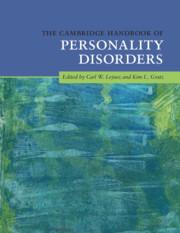Book contents
- The Cambridge Handbook of Personality Disorders
- The Cambridge Handbook of Personality Disorders
- Copyright page
- Contents
- Figures
- Tables
- Contributors
- Preface
- Part I Etiology
- Part II Models
- Part III Individual Disorders and Clusters
- Part IV Assessment
- 14 Methods and Current Issues in Dimensional Assessments of Personality Pathology
- 14a The Clinical Utility and Applications of Dimensional Assessments of Personality Pathology: Commentary on Methods and Current Issues in Dimensional Assessments of Personality Pathology
- 14b New and Continuing Developments in the Assessment of Personality Disorders: Commentary on Methods and Current Issues in Dimensional Assessments of Personality Pathology
- 14c The Importance of Multiple Sources, Longitudinal Assessment, and Clinical Utility: Author Rejoinder to Commentaries on Methods and Current Issues in Dimensional Assessments of Personality Pathology
- 15 Categorical Assessment of Personality Disorders: Considerations of Reliability and Validity
- 15a Categories, Constructs, and the Assessment of Personality Pathology: Commentary on Categorical Assessment of Personality Disorders
- 15b The Need for a More Rigorous Approach to Diagnostic Reliability: Commentary on Categorical Assessment of Personality Disorders
- 15c Balancing Hopeful and Pessimistic Views of the Future of Categorical Assessment: Author Rejoinder to Commentaries on Categorical Assessment of Personality Disorders
- 16 Assessment of Mechanisms in Personality Disorders
- 16a Parts, Wholes, and Explanations of Personality and Its Pathologies: Commentary on Assessment of Mechanisms in Personality Disorders
- 16b Genetic and Environmental Mechanisms in BPD over the Lifespan: Commentary on Assessment of Mechanisms in Personality Disorders
- 16c Complexity and Transactions: Author Rejoinder to Commentaries on Assessment of Mechanisms in Personality Disorders
- Part V Treatment
- Index
- References
14a - The Clinical Utility and Applications of Dimensional Assessments of Personality Pathology: Commentary on Methods and Current Issues in Dimensional Assessments of Personality Pathology
from Part IV - Assessment
Published online by Cambridge University Press: 24 February 2020
- The Cambridge Handbook of Personality Disorders
- The Cambridge Handbook of Personality Disorders
- Copyright page
- Contents
- Figures
- Tables
- Contributors
- Preface
- Part I Etiology
- Part II Models
- Part III Individual Disorders and Clusters
- Part IV Assessment
- 14 Methods and Current Issues in Dimensional Assessments of Personality Pathology
- 14a The Clinical Utility and Applications of Dimensional Assessments of Personality Pathology: Commentary on Methods and Current Issues in Dimensional Assessments of Personality Pathology
- 14b New and Continuing Developments in the Assessment of Personality Disorders: Commentary on Methods and Current Issues in Dimensional Assessments of Personality Pathology
- 14c The Importance of Multiple Sources, Longitudinal Assessment, and Clinical Utility: Author Rejoinder to Commentaries on Methods and Current Issues in Dimensional Assessments of Personality Pathology
- 15 Categorical Assessment of Personality Disorders: Considerations of Reliability and Validity
- 15a Categories, Constructs, and the Assessment of Personality Pathology: Commentary on Categorical Assessment of Personality Disorders
- 15b The Need for a More Rigorous Approach to Diagnostic Reliability: Commentary on Categorical Assessment of Personality Disorders
- 15c Balancing Hopeful and Pessimistic Views of the Future of Categorical Assessment: Author Rejoinder to Commentaries on Categorical Assessment of Personality Disorders
- 16 Assessment of Mechanisms in Personality Disorders
- 16a Parts, Wholes, and Explanations of Personality and Its Pathologies: Commentary on Assessment of Mechanisms in Personality Disorders
- 16b Genetic and Environmental Mechanisms in BPD over the Lifespan: Commentary on Assessment of Mechanisms in Personality Disorders
- 16c Complexity and Transactions: Author Rejoinder to Commentaries on Assessment of Mechanisms in Personality Disorders
- Part V Treatment
- Index
- References
Summary
Evans et al. (this volume) reviewed prominent dimensional measures of personality, discussed the clinical usefulness of these measures, and provided an overview of personality assessment issues. This commentary focuses on the clinical utility and applications of personality traits and assessment, as well as factors relevant to bridging the research-to-practice gap. In order to adequately disseminate and implement evidence-based personality assessments into practice, personality pathology researchers should be taking active steps to move the empirical base (e.g., validated models of personality, evidence-based assessments, aspects of clinical utility) into application. The process of translating these traits and measures into practice may include assessing barriers to use among practitioners, addressing matters of acceptability and feasibility, and providing training and consultation to practitioners. The authors review benefits of including adaptive traits in assessment and practice (e.g., assist with collaborative treatment planning, decrease stigma), provide commentary on the incremental utility of dysfunction including the use of external correlates, and outline the importance of bipolarity of dimensional trait measures.
Keywords
- Type
- Chapter
- Information
- The Cambridge Handbook of Personality Disorders , pp. 347 - 349Publisher: Cambridge University PressPrint publication year: 2020

